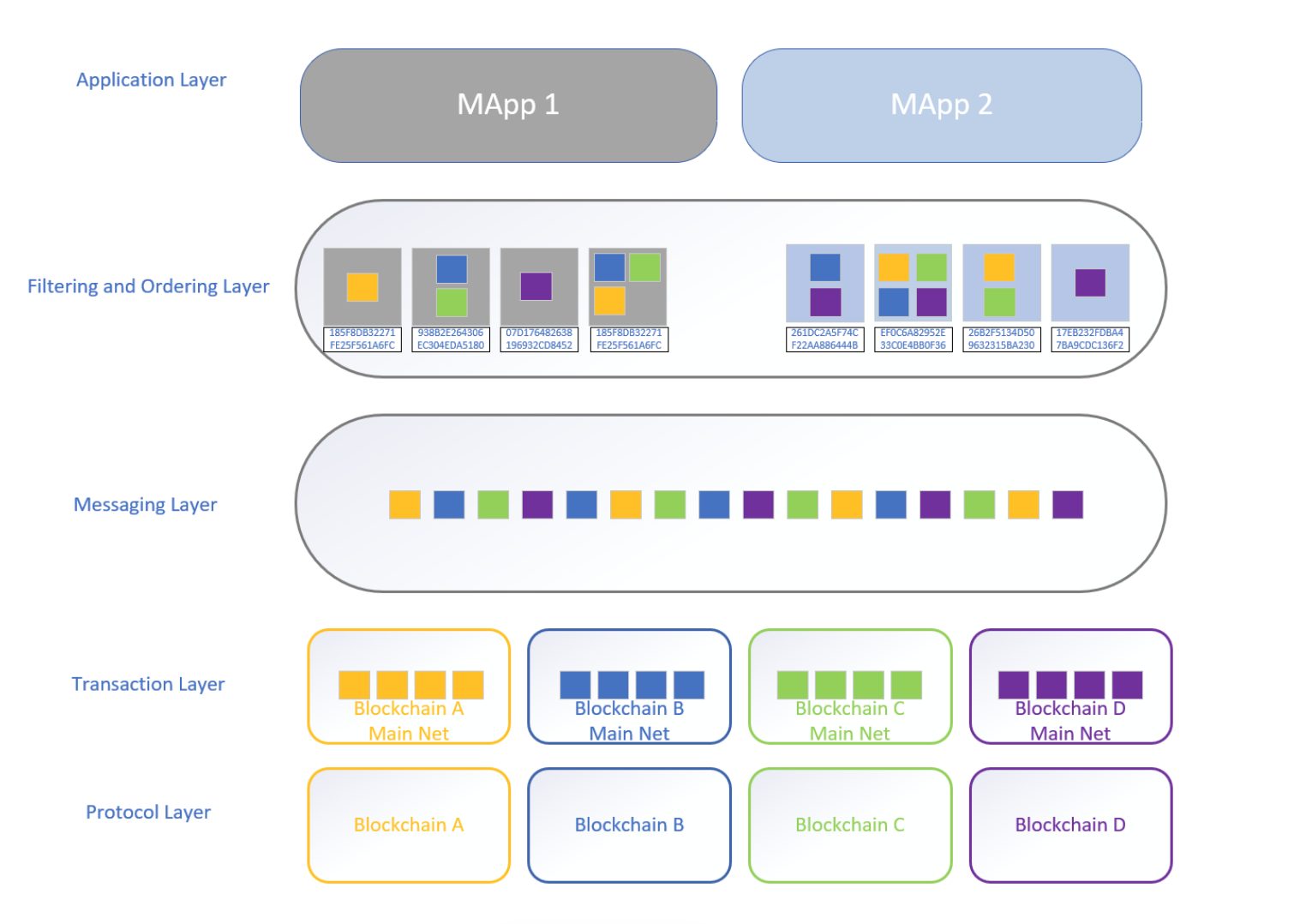Key info (as of June 22, 2022):
- Circulating Supply — 12,072,738.00 QNT
- Total Supply — 14,612,493 QNT
- Sector — Interoperability
- Token Type — ERC-20
- Token Usage — Access
- ATH — $428.38
- ATH Date — September 11, 2021
Overview
What is Quant (QNT)?
The main goal of Quant is to connect blockchains and existing networks on a global scale for businesses and developers to create next-generation multi-chain applications. The project’s backbone is the Overledger network, which is built as a blockchain operating system that uses a simple plug-and-play solution to solve the interoperability problem. It means Overledger doesn’t require developers and enterprises to deploy any new infrastructure to join blockchain networks. Furthermore, Overledger can be used for connecting an application to other applications in the same blockchain ecosystem.
To maintain multiple blockchain interactions, Quant uses various layers for decentralized and traditional apps to interact at different levels. Quant creates various layers for transactions, messaging, filtering and ordering, and an application for sharing and referencing identical messages related to other applications.
With Overledger, developers can build decentralized multi-chain applications (known as MApps) using smart contracts. However, to build and maintain these applications, developers must hold a certain amount of Quant tokens (QNT). QNT is an ERC-20 token and can be described as a utility token for the Quant ecosystem. It is predominantly used to pay for apps and services on Quant, as well as for staking/holding and paying license fees.
A brief history of Quant
The company behind Quant’s network development was founded in 2015 by Gilbert Verdian. He created the Blockchain ISO Standard TC307, which is now being used by more than 50 countries for blockchain development to achieve interoperability between different blockchains and allow blockchain networks to function within existing traditional systems.
In 2018, Gilbert Verdian announced the Quant network idea to offer a blockchain interoperability network and operating system. The project was funded through an initial coin offering (ICO) in the same year and was able to raise $11 million, selling around 10 million tokens or around 70%. It is considered that ICO didn’t help the project achieve funding goals in full at the beginning of its development.
However, the project received an undisclosed amount of funding from Alpha Sigma Capital in July 2020, which helped them achieve the goals the project outlined in their announcement. In the same month, Quant’s Overledger version 1.0 went live, providing interconnection for multiple public blockchains and private networks to facilitate the creation of multi-chain applications. At that time, Overledger supported 11 permissioned and permissionless decentralized ledgers, including Corda, Hyperdger, and JPM Quorum.
In May 2021, Quant released Overledger 2.0, providing interoperability to Ethereum, XRP, and Bitcoin mainnets. In addition, the project introduced the concept of “one API for everything,” a standardized API interface for developers, and implemented authentication standards to increase security and scalability. The platform doesn’t have a fixed roadmap but the team behind the platform is largely focused on onboarding developers, as well as expanding the list of supported blockchains and applications in the Overledger ecosystem. At the moment of writing, the last Overledger version is 2.2.8 which added the support of the XDC network.

Overview of the Quant Ecosystem. Source: Medium
How does Quant work?
Overledger and its layers
Quant can seamlessly connect different networks by using a technology called Overledger DLT gateway. It is used as a simple API gateway to various distributed ledgers, allowing centralized and decentralized projects to connect their pre-existing infrastructure to preferred blockchain networks. For that, Quant selected the ubiquitous REST API which provides a standardized way to interface with a wide variety of networks.
To solve various interoperability challenges, Overledger uses four layers that perform different functions:
- Transaction layer. This layer stores the transactions added to a blockchain and all relevant components for blockchains to reach consensus, including full nodes and thin clients. Each supported ledger in the Overledger ecosystem is isolated, meaning all transactions executed in a specific blockchain are only valid for that ledger.
- Messaging layer. This layer takes the transaction data (smart contracts, metadata) from isolated blockchains in the transaction layer and places it in the shared channel where transactions from all ledgers are stored.
- Filtering and ordering layer. This layer takes messages from the previous layer and filters them based on rules defined by a specific MApp and orders them into so-called verification blocks.
- Application layer. This layer defines the rules of how other layers operate and updates the MApps state using information received from the filtering and ordering layer. Each MApp is isolated in this layer.

Overledger layers. Source: Medium
MApps
Multi-chain applications, or MApps, are essentially smart contracts that exist across multiple distributed ledgers. They allow decentralized applications to leverage the data received from different networks to perform operations in several networks simultaneously, Quant also supports so-called multi-ledger tokens (MTLs) or digital assets backed by real funds in external sources. These MTLs can be used as stablecoins, loyalty points, central bank digital currencies, which are issued and used across multiple distributed ledgers using Overledger technology.
Each MApp is isolated in the Overledger ecosystem and contains the business logic. When creating multi-chain applications, developers need to determine rules on how to interact with the Overledger system and with other applications. If necessary, applications in different networks can communicate with each other by putting messages on the messaging layer.
MApps may use so-called treaty contracts to help smart contacts in one network recognize status and operations by smart contracts in other networks. Treaty contracts can be described as smart contracts that are run off-chain for higher performance and provide the ability to run smart contracts across several blockchains, even those which do not support smart contracts such as the Bitcoin network.
Overledger use case
Let’s say you have a MApp which represents a marketplace that sells certain products. MApp contains rules that if the customer buys your product in bitcoin, you will automatically pay your product supplier in ether, send some XRP to the delivery company to deliver the product to the customers, and send some part of bitcoin to your own reserve fund. It means when customers buy a product, it triggers smart contracts in different networks to perform certain actions. The ETH and XRP transactions, as well as the BTC transaction to the reserve fund, will happen simultaneously once the initial customer’s BTC transaction is confirmed.
This is only one potential way to use Quant’s Overledger system to achieve interoperability and maintain operations in several networks at the same time. Some other Quant use cases may include creating interoperable tokens which exist in different blockchains or performing cross-chain token swaps.
Quant’s native token
Utility
The QNT token is an Ethereum-based utility token that is intended to provide digital access to the Overledger ecosystem. QNT tokens must be provided by enterprises and developers in exchange for an annual license for using Overledger features. However, the price of the access is fixed in fiat currencies, meaning enterprises and developers don’t need to purchase QNT for the license. They pay for the license in fiat to the Quant Treasury which handles the conversion of fiat to QNT. QNT funds used for license fees remain locked for 12 months in layer 2 (L2) payment channels.
In addition, every enterprise or developer who wants to run MApps needs to hold a certain number of QNT tokens. As long as QNT tokens are staked, developers may create and maintain their MApps. Developers may monetize their MApps and may use the treasury as a payment processor to charge payments for subscription or one-time transactions. Such monetization is assumed to be achieved using fiat currencies or digital currencies, including QNT. End customers may also hold and pay with QNT tokens to get access to MApps and use services within the Overledger ecosystem.
Token allocation
The initial token supply differs from the current one because the team behind the project completed a burn of 9,545,765.950989192 QNT. The reason is considered to be the ICO which hasn’t achieved set goals because of difficult market conditions at that time (bear market). The current total QNT supply is fixed and contains 14,612,493 QNT tokens.
The QNT tokens are assumed to be split in the following way:
- 9,964,259 QNT — tokens sold during the public ICO, pre-sale, and private funding rounds.
- 2,649,493 QNT — the Quant company reserve which is used for research and development, building infrastructure, and other purposes.
- 1,347,988 QNT — tokens that belong to the company founders.
- 650,753 QNT — tokens that belong to the company advisors and staff.
The current circulation supply excludes Quant’s company reserve, which may vary depending on the Quant company strategy.

QNT Token Allocation. Source: Coin98
Find out more about Quant
Quant’s Overledger operating system is billed as the first blockchain gateway for businesses and developers who are looking for ways to achieve interoperability in a fast and secure way. The team behind Quant is constantly working on enlarging the list of support networks and applications to expand the opportunities provided to developers. With the evolving Overledger ecosystem, developers and enterprises may find more options to join blockchain networks and take advantage of the crypto solutions they provide.
CEX.IO empowers users to buy QNT and get access to the Overledger ecosystem and features that MApps may offer.
Disclaimer: Information provided by CEX.IO is not intended to be, nor should it be construed as financial, tax, or legal advice. The risk of loss in trading or holding digital assets can be substantial. You should carefully consider whether interacting with, holding, or trading digital assets is suitable for you in light of the risk involved and your financial condition. You should take into consideration your level of experience and seek independent advice if necessary regarding your specific circumstances. CEX.IO is not engaged in the offer, sale, or trading of securities. Please refer to the Terms of Use for more details.

You can get bonuses upto $100 FREE BONUS when you:
💰 Install these recommended apps:
💲 SocialGood - 100% Crypto Back on Everyday Shopping
💲 xPortal - The DeFi For The Next Billion
💲 CryptoTab Browser - Lightweight, fast, and ready to mine!
💰 Register on these recommended exchanges:
🟡 Binance🟡 Bitfinex🟡 Bitmart🟡 Bittrex🟡 Bitget
🟡 CoinEx🟡 Crypto.com🟡 Gate.io🟡 Huobi🟡 Kucoin.




















Comments